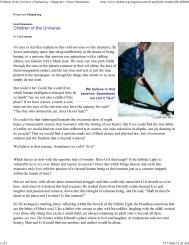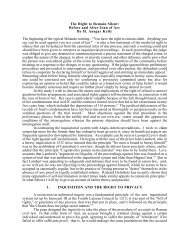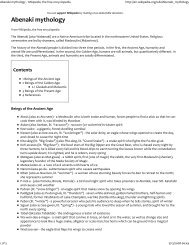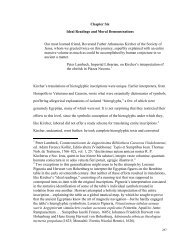sefi;g:v. - A Kabbalist walks into a bar, and the
sefi;g:v. - A Kabbalist walks into a bar, and the
sefi;g:v. - A Kabbalist walks into a bar, and the
Create successful ePaper yourself
Turn your PDF publications into a flip-book with our unique Google optimized e-Paper software.
SCYTHIANS SCYTHIANS<br />
Tabiti (‘Iun‘q, Vesta), goddess of <strong>the</strong> fire ; Papaw (probably<br />
Papai or Babai, Zeus), <strong>the</strong> heaven-fa<strong>the</strong>r ;<br />
12. Religion. Api (ye), <strong>the</strong> earth : Oitosyrus (Apollo, possibly<br />
descriptive name of Xlithra), <strong>the</strong> Sun ;<br />
Artimpasa (Aphrodite Urania), Venus ; Thamisadas (Poseidon),<br />
<strong>the</strong> Sea ; Herakles <strong>and</strong> Ares.<br />
The Scythians had no images, or altars, or temples.<br />
Their chief sacrifices were horses, which <strong>the</strong>y offered in<br />
a peculiar manner ; but prisoners inwarwere also at times<br />
offered. Only <strong>the</strong> god of war had a few great shrines.<br />
There is evidence of ancestral cults. Divination by<br />
rods or linden <strong>bar</strong>k was practised, <strong>and</strong> <strong>the</strong> soothsayers<br />
formed distinct classes. A comparison with Persian<br />
divinities <strong>and</strong> religious customs shows a remarkable<br />
similarity. Whilst a heptad of divinities occurs (‘AB-<br />
Gap&), <strong>the</strong>re is no trace of Ahura Mazda. Whe<strong>the</strong>r<br />
any of <strong>the</strong> E. Scythians accepted <strong>the</strong> Mazdayasnian faith,<br />
is not known.<br />
Buddhism may have made some<br />
ro ess amonF <strong>the</strong> Sse in<br />
Kipin <strong>and</strong> Punjab; but <strong>the</strong> Yuecii Ens Kaniska (78 A.D.)<br />
seems to have been <strong>the</strong> first monarch officlally to embrace that<br />
form of religion.<br />
The earlier Greek writers speak in terms of high<br />
13. Character praise of <strong>the</strong> character of <strong>the</strong><br />
8nd civilisation. Fythians, giving instances of <strong>the</strong>ir<br />
justice, sincerity, love of truth, <strong>and</strong><br />
sharp intelligence.<br />
It is possible, however, that <strong>the</strong>se descriptions have to some<br />
extent been coloured by d#rimireasoning as to <strong>the</strong> virtuesof a<br />
nomadic life, such as may still be found in modern works. On<br />
<strong>the</strong> o<strong>the</strong>r h<strong>and</strong> <strong>the</strong> less flattering tone of later authors was,<br />
no doubt due ’in no small measure to <strong>the</strong>ir confusion of <strong>the</strong><br />
Scythian: with <strong>the</strong>ir ruder Slavonic, Finno-Ugric, <strong>and</strong> Turkish<br />
neighbours. In Roman times, <strong>the</strong> conflicts with <strong>the</strong> Sarmatians<br />
naturally added bitterness to <strong>the</strong> references to Scythians.<br />
The Scythians probably possessed, in addition to <strong>the</strong><br />
general characteristics of all Iranian peoples, some<br />
qualities peculiar to that nomadic life so large a part of<br />
<strong>the</strong>m continued to lead. The rale which <strong>the</strong> ASkuza<br />
played in Asia, at a time when <strong>the</strong> Assyrian empire had<br />
reached its greatest extent, <strong>and</strong> in <strong>the</strong> days of its decad-<br />
ence, indicates a somewhat highly developed political<br />
organisation <strong>and</strong> a certain adaptability to conditions of<br />
settled life, sagacity as well as energy, diplomacy not<br />
~. .<br />
less than enterprise.<br />
In Russia <strong>the</strong> long contact of <strong>the</strong> Scythms with Greek civilisa-<br />
tion, at a time wheii it had attained its very highest development,<br />
could not but exercise a profound influence upon <strong>the</strong>m. The<br />
antiquities found on <strong>the</strong> Kimmerian Bosphorus, now in <strong>the</strong><br />
Hermitage in St. Petenburg, am ly prove what <strong>the</strong> tastes of<br />
Scythian lords were <strong>and</strong> what enviagle means <strong>the</strong>y had of gratify-<br />
ing <strong>the</strong>m. One class of <strong>the</strong>se finds probably represents <strong>the</strong> work<br />
of native artists trained upon Grecian models. These Scythian<br />
mastersproduceda type ofart <strong>the</strong> influenceofwhichmaybe traced<br />
beyond (N. of) <strong>the</strong> Baltic. Since some tribes had for centuries<br />
cultivated <strong>the</strong> soil, <strong>and</strong> large numbers of Scythians lived in cities<br />
many nobles undoubtedly had <strong>the</strong>ir residences built by Greed<br />
architects. King Skyles had a palace in Olbia Concerning<br />
<strong>the</strong>ir industrial skill, we have no information, except that <strong>the</strong>y<br />
excelled in metallurgy. In Bactria <strong>the</strong> Scythians became <strong>the</strong><br />
heirs of ano<strong>the</strong>r Greek civilisation ; <strong>and</strong> in India <strong>the</strong>y evidently<br />
adapted <strong>the</strong>mselves to native <strong>and</strong> Greek traditions, not without<br />
<strong>the</strong>mselves exerting an iniluence upon <strong>the</strong> life of Punjab <strong>and</strong><br />
Sindh.<br />
Concerning <strong>the</strong> period in which <strong>the</strong> Scythians still<br />
had for <strong>the</strong>ir neighbours in <strong>the</strong> Airyanem Vaejo<br />
14. History : (Vendidad, I) <strong>the</strong> o<strong>the</strong>r branches of <strong>the</strong><br />
Iranian family, before <strong>the</strong>se Lad passed<br />
;:$’<br />
<strong>into</strong> Sogdiana, Margiana, Bactria, Hyr-<br />
cania, Herat, <strong>and</strong> Kabul, we possess no<br />
direct information. The presence of Iranian names in<br />
<strong>the</strong> Amarna Tablets <strong>and</strong> early Assyrian <strong>and</strong> Egyptian<br />
inscriptions indicated by Ball (PSBA, 1882, pp, 4245),<br />
Bezold-Budge ( TeZZ el Amama TadZetseis, 1892, p. xiv),<br />
Rost (MYAG, 1897), <strong>and</strong> especially Hommel (Sitz.ber.<br />
Bihm. Ges. d. Wisr. 1898), seems to show that<br />
Anatolia, Mesopotamia, Syria, <strong>and</strong> Elam had already<br />
become acquainted with some members of <strong>the</strong> Iranian<br />
familv in <strong>the</strong> sixteenth centurv R.C.<br />
According to <strong>the</strong> native tradhon of <strong>the</strong> Scoloti found in<br />
Olbia by Herodotus (4 7) <strong>the</strong> first king of Scythia, Targitaus,,<br />
reigned 1000 years befoie Darius Hystaspis ’<strong>and</strong> no more.<br />
We have no means of determining on what data this computation<br />
rests <strong>and</strong> its historical value appears doubtful, Targitaus<br />
himself bbing probably a mythical personage. Hommel con-<br />
4337<br />
nects this story with <strong>the</strong> accounts of a Scythian conquest as far<br />
as <strong>the</strong> Nile <strong>and</strong> an invasion of Asia to <strong>the</strong> borders of Syria by<br />
an Amazonian queen (Diodorus. 2 43 46), <strong>and</strong> regards Strabo’s<br />
(1516) Idanthyrsus as a mistake for Targitaus. But it is<br />
probable that <strong>the</strong> accounts ir, Diodorus are onty reflections<br />
of <strong>the</strong> invasion in <strong>the</strong> time of Psammetichus, <strong>and</strong> that Idan-<br />
thyrsus has in Straho received credit for <strong>the</strong> work accomplished<br />
by Madyas. The narratives of <strong>the</strong> conquest of Scythia by<br />
Sesostris (Ramessu 11.) are clearly late exaggerations ; but<br />
Honimel’s notahle <strong>the</strong>ory accounting for Iranian names in<br />
Kadavaduna (=Cappadoda, a country closely allied to <strong>the</strong><br />
centre of Hittite power, Melitene, <strong>and</strong> Cilicia; see Muller<br />
Asien, 288,335) by <strong>the</strong> Scythian character of its people, alsd.<br />
tends to explain this confusion of Hittite <strong>and</strong> Scythian. The<br />
people called Gag may prove to be akin to <strong>the</strong> Kimmerians <strong>and</strong><br />
forerunners of <strong>the</strong> AHkuza. As regards <strong>the</strong> history of <strong>the</strong><br />
Scoloti in Russian Scythia before <strong>the</strong>ir contact with <strong>the</strong> Greeks<br />
in <strong>the</strong> seventh century, we have no information.<br />
From tablets inscribed in <strong>the</strong> reign of Esarhaddon<br />
(681-668) we learn that Scythians had established<br />
16. asianic rule : <strong>the</strong>mselves N. of Lake Urumiah.<br />
Protothyas,<br />
mIIadyas.<br />
Fear is expressed lest <strong>the</strong> Scythians<br />
should break through Mannzean <strong>into</strong><br />
Assyrian territory, <strong>the</strong> chief IBpakai<br />
is said to be an ally of <strong>the</strong> Mannzeans, <strong>and</strong> king<br />
Bartatua (Protothyas) is referred to as seeking an<br />
alliance <strong>and</strong> <strong>the</strong> h<strong>and</strong> of Esarhaddon’s daughter. That<br />
<strong>the</strong> alliance was concluded is highIy probable. since in<br />
625 Madyas, Protothyas’ son, came to <strong>the</strong> aid of<br />
Assyria by defeating Cyaxares. who was besieging<br />
Nineveh, <strong>and</strong> by checking <strong>the</strong> advances of Psammetichus<br />
in Syria. In consideration of <strong>the</strong>se services,<br />
it is natural that <strong>the</strong> suzerainty of Assyria over Urartu<br />
acknowledged by Sarduris 111. should pass to Scythia,<br />
<strong>and</strong> that such states as Cappadocia, Commagene, <strong>and</strong><br />
Melitene should become tributary. What <strong>the</strong> relation<br />
of Cilicia to <strong>the</strong> new power was, it would be interesting<br />
to know ; but it cannot yet be discerned. The Median<br />
border states Atropatene, Matiene, <strong>and</strong> o<strong>the</strong>rs are<br />
likely to have been subdued. From 625 to 597<br />
Scythian rule in Asia Minor continued. Then <strong>the</strong><br />
power was broken by Cyaxares. In 591 Scythian<br />
refugees from <strong>the</strong> Median court fled to Lydia for protection<br />
; but Scythians continued to live under Median<br />
<strong>and</strong> Persian domination in Asia Minor. There was a<br />
Sacastene in Cappadocia as well as in Armenia.<br />
Darius claims to have conquered <strong>the</strong> ‘ Saka beyond<br />
<strong>the</strong> Sea.’ Bv <strong>the</strong>se he means <strong>the</strong> Scvthians N. of <strong>the</strong><br />
18. Scythi& Euxine. He probadfy also refers to<br />
<strong>the</strong>m as <strong>the</strong> saka tipukhuda, since<br />
inR~ssi&<br />
<strong>the</strong> Dictorial remesentations from <strong>the</strong><br />
Kimmerian Bosporus show that <strong>the</strong>se wore <strong>the</strong> Phrygian<br />
cap. It is to Darius’ campaign <strong>into</strong> Russia in 512 that<br />
we owe <strong>the</strong> elaborate account of <strong>the</strong> Scythians by Hero-<br />
dotns. That Darius marched as far as to <strong>the</strong> Volga<br />
may be doubted, <strong>and</strong> some o<strong>the</strong>r points in <strong>the</strong> narrative<br />
are manifestly unhistorical.<br />
There is no reason, however, to question <strong>the</strong> important rale<br />
ascribed to Idanthyrsus, through whose admit management of<br />
<strong>the</strong> defence Darius was frustrated in his object. His fa<strong>the</strong>r<br />
Saulius seems to have already impressed himself upon <strong>the</strong><br />
colonists, as his name is especially mentioned No events of<br />
any importance, however, have been recorded by <strong>the</strong> Greek<br />
writers before Herodotus who refer to <strong>the</strong> Scythians. Whe<strong>the</strong>r<br />
<strong>the</strong> use by <strong>the</strong>m of<strong>the</strong> name Scythian (P&hp) shows that <strong>the</strong>ir<br />
knowledge of <strong>the</strong> people was derived from <strong>the</strong> Agkuza of Asia<br />
Minor, or that Sku-za was as much a native designation of <strong>the</strong><br />
people as Sko-lot, cannot be determined.<br />
The Milesian colonists were, of course, tributary to<br />
<strong>the</strong> Scythian suzerain ; but <strong>the</strong> relations seem to have<br />
been cordial.<br />
Only when a king like Skylas forgot his native traditions to<br />
<strong>the</strong> extent of takin part in <strong>the</strong> Dionysiac orgies in Olbia, <strong>the</strong><br />
Scythians resented!& proceeding. Friendly relations also pre-<br />
vailed between Ariapei<strong>the</strong>s <strong>and</strong> Teres of Thrace, in <strong>the</strong> beginning<br />
of <strong>the</strong> fifth century. It is doubtful whe<strong>the</strong>r Spartacus (438-432),<br />
<strong>the</strong> founder of <strong>the</strong> Bosporanian kingdom, was a Greek or of mixed<br />
race. There are some indications that <strong>the</strong> king whose skeleton<br />
was found in a tomb at Kertsch (Panticapieum) had Scythian<br />
blood in his veins. The Spartacidae were not a serious menace to<br />
Scythian power in <strong>the</strong> fourth century. Danger threatened first<br />
from Macedonia, whose ambitious ruler Philip invaded Scythia<br />
<strong>and</strong> killed ip battle king Ateas in 39, <strong>and</strong> subsequently from<br />
<strong>the</strong> Sarmatiails who crossed <strong>the</strong> &on <strong>and</strong> made <strong>the</strong>mselves<br />
during <strong>the</strong> third century <strong>the</strong> most important people in <strong>the</strong><br />
4338

















